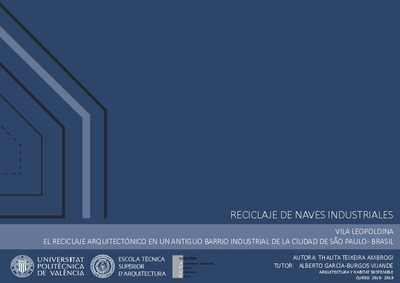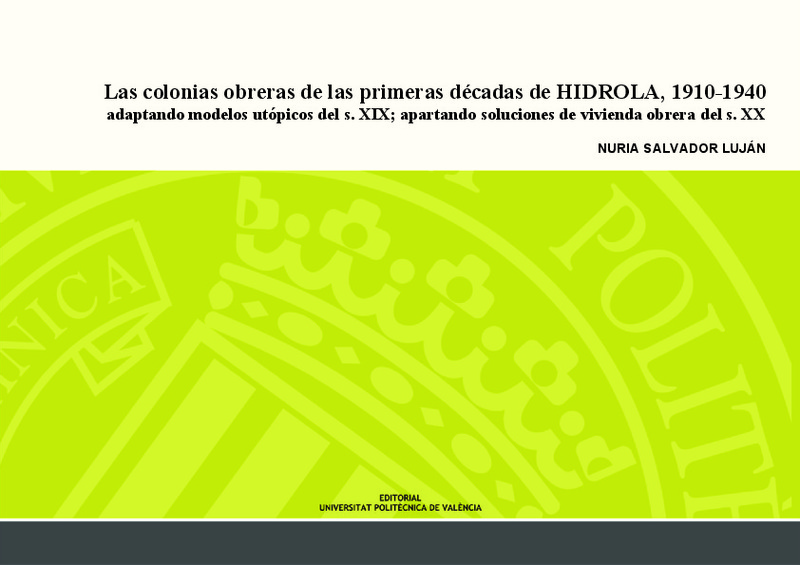|
Resumen:
|
[ES] Este presente trabajo analiza específicamente el reciclaje de naves industriales en un barrio en el extremo oeste de la ciudad de São Paulo, Brasil. Así como muchas ciudades contemporáneas, São Paulo posee una gran ...[+]
[ES] Este presente trabajo analiza específicamente el reciclaje de naves industriales en un barrio en el extremo oeste de la ciudad de São Paulo, Brasil. Así como muchas ciudades contemporáneas, São Paulo posee una gran cantidad de almacenes y antiguas naves industriales en desuso, frutos de la desindustrialización de la ciudad.
La Vila leopoldina, tradicional barrio industrial, vive actualmente un período de cambio de usos. La actividad industrial viene abandonando la región, lo que crea una especie de vacío urbano que queda disponible al interés de otras actividades económicas. La parte baja del barrio, próxima a la confluencia de los ríos Pinheiros y Tietê, además del CEAGESP (Empresa de Almacenes Generales de São Paulo), todavía mantiene un paisaje industrial, la infraestructura construida de los almacenes y naves industriales despierta interés del sector terciario.
El principal atractivo de la región se da por su eficaz red de transporte. El barrio se ubica en la Marginal Pinheiros, vía urbana de carácter regional y que conecta con las principales carreteras estatales y adicionalmente es atendido por la línea del tren (CPTM). Estas características hacen de la región un punto de especial interés para las empresas del sector audiovisual. Se verifica una creciente concentración de estudios, productoras y agencias de propaganda que vienen consolidándose el proceso de formación del polo audiovisual del estado de São Paulo. Las antiguas naves industriales proporcionan espacios amplios, robustos y flexibles para intervenciones arquitectónicas.
Tal fenómeno tuvo inicio en los años 2000 y viene consolidándose desde entonces. El nuevo público hizo con que surgieran nuevos restaurantes y bares alrededor, de los cuales algunos también han reciclado antiguas naves o pequeños almacenes existentes, construyendo espacios sugerentes haciéndonos reflexionar sobre la importancia del reciclaje de la arquitectura en naves industriales y sus más diversas posibilidades.
[-]
[EN] ABSTRACT
This paper specifically analyzes the recycling of industrial buildings in a neighborhood on the extreme left of the city of São Paulo, Brazil. Like many contemporary cities, São Paulo has a great amount of ...[+]
[EN] ABSTRACT
This paper specifically analyzes the recycling of industrial buildings in a neighborhood on the extreme left of the city of São Paulo, Brazil. Like many contemporary cities, São Paulo has a great amount of warehouses and old unused industrial buildings, results of the deindustrialization of the city.
Vila Leopoldina, a traditional industrial neighborhood, is currently experiencing a period of change of its use. The industrial activity has been leaving the region, creating a kind of urban emptiness that is available to other economic activities. The area near the confluence of Pinheiros and Tietê rivers, in addition to the CEAGESP (General Warehouses Company of São Paulo), still keeps an industrial landscape, the built infrastructure of warehouses and industrial buildings arouses the tertiary sector interests.
The main attraction of the area is its efficient transport system. The neighborhood is located in Marginal Pinheiros, a regional road that connects the main state roads, beside being served by the train line (CPTM). These characteristics make the region in a point of special interest for audiovisual companies. There is a growing concentration of studios, film producers and publicity agencies which are consolidating and concentrating the audio-visual market of the state of São Paulo. The old industrial buildings provide spacious, robust and flexible spaces for architectural interventions.
This phenomenon began in the 2000s and has been strengthening since then. The new public made emerge restaurants and bars in the surroundings and some of them have also recycled old warehouses or small industrial buildings, creating interesting spaces that make us reflect on the importance of recycling architecture in industrial buildings and their diverse possibilities.
[-]
|









